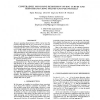Free Online Productivity Tools
i2Speak
i2Symbol
i2OCR
iTex2Img
iWeb2Print
iWeb2Shot
i2Type
iPdf2Split
iPdf2Merge
i2Bopomofo
i2Arabic
i2Style
i2Image
i2PDF
iLatex2Rtf
Sci2ools
ICIP
1995
IEEE
1995
IEEE
Constrained monotone regression of ROC curves and histograms using splines and polynomials
Receiver operating characteristics (ROC) curves have the property that they start at (0,l) and end at (1,O) and are monotonically decreasing. Furthermore, a parametric representationfor the curves is more natural, since ROCs need not be single valued functions: they can start with infinite slope. In this article we show how to fit parametric splines and polynomials to R O C data with the end-point and monotonicity constraints. Spline and polynomial representations provide us a way of computing derivatives at various locations of the R O C curve, which are necessary in order to find the optimal operating points. Density functions are not monotonic but the cumulative densityfunctions are. Thus in order to fit a spline to a density function, we fit a monotonic spline to the cumulative density function and then take the derivative of the fitted spline function. Just as ROCs have end-point constraints, the density functions have end-point constraints. Furthermore, derivatives of splines ar...
Cumulative Density Function | Fitted Spline Function | ICIP 1995 | Image Processing | Spline Functions |
| Added | 29 Oct 2009 |
| Updated | 29 Oct 2009 |
| Type | Conference |
| Year | 1995 |
| Where | ICIP |
| Authors | Tapas Kanungo, D. M. Gay, Robert M. Haralick |
Comments (0)

